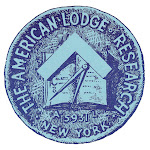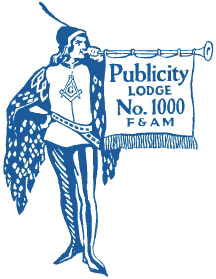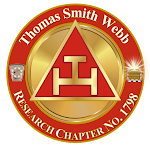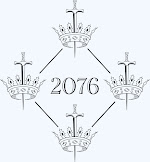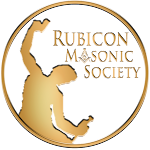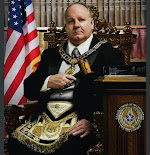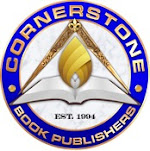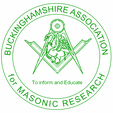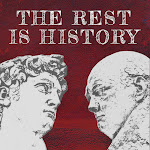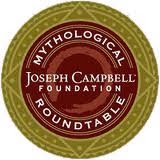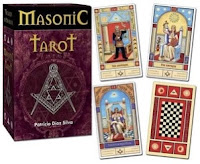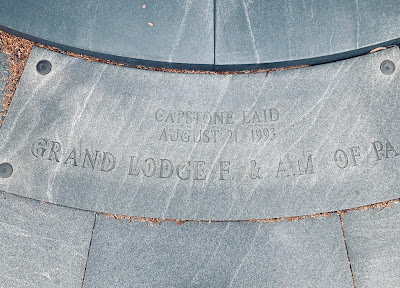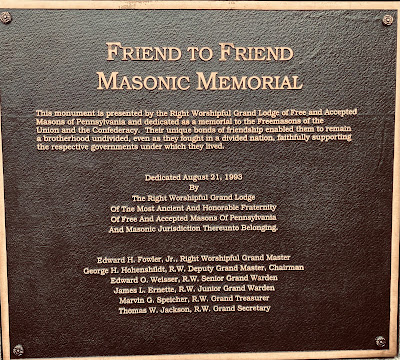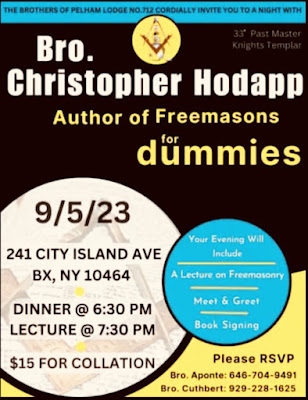A few of us in attendance at New Jersey’s research lodge Saturday (see post below) also very much wanted to be at the George Washington Masonic National Memorial for the annual meeting of the Masonic Library and Museum Association, but we haven’t the seniority in the fraternity to use the transporter, thus missing the peaceful transfer of power there.
Monday, September 11, 2023
‘MLMA elects new leaders'
A few of us in attendance at New Jersey’s research lodge Saturday (see post below) also very much wanted to be at the George Washington Masonic National Memorial for the annual meeting of the Masonic Library and Museum Association, but we haven’t the seniority in the fraternity to use the transporter, thus missing the peaceful transfer of power there.
Speaking of New Jersey, Glenn Visscher is the MLMA’s new president. Glenn and his family created the Museum of Masonic Culture at the Scottish Rite Valley of Northern New Jersey about twenty years ago. The museum was relocated to the Trenton Masonic Temple twelve years ago and it is a very well rounded repository of material culture with regalia and memorabilia from across the Masonic spectrum, plus artifacts from early New Jersey Masonry, and a lot more. There also is a library—not a research library, but a sizable collection of books that can help a history lover get going down the path.
Tyler Vanice, the now immediate past president, is the new secretary. Dirk Hughes, of the Michigan Masonic Museum and Library, is vice president. Eric Trosdahl remains as treasurer. I think he’s been treasurer for about fifteen years.
Congratulations to all! I’m looking forward to whatever might be in store in the coming year.
Sunday, September 10, 2023
‘An encouraging word to spread the Light’
 |
| RW Bro. Rich was our lone presenter yesterday at New Jersey Lodge of Masonic Research and Education 1786. He will be appointed Grand Historian in November. |
A quick, but enjoyable, meeting of New Jersey Lodge of Masonic Research and Education 1786 was the highlight of my yesterday. We had just one presenter, Bro. Rich, who is to become his grand lodge’s grand historian come November. His talk wasn’t a paper on history, however, it was what one would categorize as speculative. Titled “The Shammesh Candle and Freemasonry: How One Candle Can Illuminate the World,” his discussion was inspired by Dr. Rachel Naomi Remen’s bestseller My Grandfather’s Blessings.
I’m not familiar with it, but the publisher says, in part:
Dr. Remen’s grandfather, an orthodox rabbi and scholar of the Kabbalah, saw life as a web of connection and knew that everyone belonged to him, and that he belonged to everyone. He taught her that blessing one another is what fills our emptiness, heals our loneliness, and connects us more deeply to life.
Rich applied the book’s concepts to Masonic thought, illustrating his points with the candles on a small menorah (after switching off the lights). The shammash (there are various English spellings of the word) candle is that center taper in the nine-branch menorah. The Chabad branch of Hasidim says:
Each of us has the potential to be a shammash. We all have a responsibility to become teachers and impact the lives of others. Just as the shammash is usually placed above the other candles, a person who serves others, a teacher, becomes great because he or she is using a set of superior skills to make others great too. Following the shammash, the path to elevation is not through pushing others down, but by sharing with them and coaxing out the flame they carry within.
There was a little post-meeting grumbling because the presentation was not a tried-by-the-square research paper, but this research lodge, per its by-laws, makes time for other than academic studies. I liked it. It’s ideal for lodge or AMD council. I hope Rich continues to bring it to the brethren.
A large group of us then retired to a local steakhouse. Somehow, I spent fifty bucks on lunch! A cheeseburger, two Oktoberfests, and the worst onion rings known to man. Well, it’s right around the corner, so…
The research lodge will meet next on Saturday, December 9, for which I am to arrange a visit by the author of a historical novel that tells of early Freemasonry. More on that to come.
Friday, September 8, 2023
‘Find the “Lost Keys” in the Reading Room’
 |
| Craftsmen Online |
I’ve organized a few book clubs over the years, and the second reading every time was Manly P. Hall’s The Lost Keys of Freemasonry for its brevity and the author’s enticing prose. And, because Hall wrote it about thirty years before he was initiated into the Craft, the book is kind of a curio. So I was delighted to learn today that the Reading Room at Craftsmen Online has chosen Chapter Five as the focus of its next discussion. From the publicity:
The Craftsmen Online Reading Room will re-open on Sunday, October 29 at 7 p.m. Our panel for the evening will be R∴W∴ Clifford T. Jacobs, Bro. Jason W. Short, R∴W∴ Bill Edwards, and V∴W∴ Michael LaRocco.
This meeting is open to the public, as all persons with an interest in the Ancient and Gentle Craft of Freemasonry are welcome. Our reading selection for October is from Bro. Manly P. Hall’s The Lost Keys of Freemasonry. We will be focusing on Chapter Five, “The Qualifications of a True Mason.” This will allow us to have a lively philosophical discussion without getting into any of the ritual work in a non-tiled setting.
No RSVP is required to attended this event. Please save the date and Zoom link on your calendar.
Thursday, September 7, 2023
‘Grand Master’s Day at Tappan’
I think I’m not really ready for September because I forgot to remind you about Grand Master’s Day at DeWint House—on Sunday!
(There also is Grand Master’s Family Day at West Point for the ball game, but that is sold out.)
That’s from noon to five. Fun, food, and music for the whole family at the historic site that served as Gen. George Washington’s headquarters during the Revolution. A beautiful place with an impressive museum in addition to the seventeenth century house. RSVP to RW Lloyd here.
Labels:
DeWint House,
Grand Master's Day,
Richard Kessler,
Tappan NY
Wednesday, September 6, 2023
‘Prince Hall Day and more’
Next Tuesday will be the 288th anniversary of the birth of Prince Hall and, accordingly, there will be celebrations in New York and New Jersey this weekend and beyond. These graphics say it all:
Tuesday, September 5, 2023
‘You guys give your $3M today?’
According to the loathsome “United Nations,” today is International Day of Charity, so join me for a minute in the following discussion on Masonic charity. Obviously, there’s much that can be said, but I’ll skip the Rite of Destitution and the measured instructions to assist brethren, widows, and orphans, and I’ll challenge our orthodoxy on “giving to charity.”
You’ve heard it countless times: “Masons give $2 million a day to charity!” And there’s a high probability that you have repeated it yourself. From what I understand, that unquestioned figure is now $3 million. “Masons give $3 million a day to charity!”
Let’s be reasonable and think this over. That daily $3M factors to about $1.1 billion a year, so the implication is Freemasons in the United States annually dig into their pockets to that sum to help others, but I’m not buying it.
The $2M figure dates to mid twentieth century, when membership in America crested at four million in 1959–or, if not precisely then, it at least was from that era. Therefore it sounded plausible, believable, and logical enough to become the mantra we all came to know. However, today the nationwide membership is down 80 percent from 1959, and we are back in nineteenth century statistics with approximately 800,000 regular Master Masons in good standing—and that’s with inconsistent census-taking from grand lodge to grand lodge. Are 800,000 Master Masons donating $1.1 billion during Anno Lucis 6023?
Come on.
Due to the manipulations of the Internal Revenue Code of the United States—try deciphering those 6,900 pages!—the nature of charitable giving has been altered, forcibly, in recent decades, and today we have charitable corporations of the 501(c) variety. Some are big, like Shriners Hospitals for Children; some are modest, like your lodge’s square club’s charity fund. The square club’s checking account is where you find the actual cash from the pockets of Masons. The Shriners Hospitals, which always has been the engine that drove the “millions per day” claim, are endowed to the billions of dollars, and actually do not need the fraternity. The fraternity needs the hospitals to legitimize its existence. When the Ancient Arabic Order of Nobles of the Mystic Shrine inevitably ceases to exist, the hospitals corporation will change its name and carry on.
I remember about fifteen years ago the expert consultants retained by the hospitals’ trustees to identify potential improvements to the system advised closing two of the then twenty-two hospitals that had gone disconcerting time without treating any patients. The trustees said no, so the two hospitals remained open, spending millions each year to maintain empty beds, and padding the famous “millions a day” boast.
Plus there are many other 501(c)(3) institutions at work: other hospitals, clinics, and care providers; medical research centers; homes for the elderly (which admit people who have no connection to the Masonic fraternity, thanks to Medicare regulations); special education schools; scholarship foundations; and who knows what else among the fifty-one grand jurisdictions in the mainstream of the Masonic society in America.
Maybe in the aggregate, and thanks to inflation, the corporate expenditures plus the local giving might total that $1.1 billion. I don’t have time to obtain the IRS 990s of all Masonic charities great and small. I just think it should be understood that:
a) bragging about charitable giving is self-aggrandizing and wrong;
b) the boast itself is misleading (if not myth); and
c) the boasting has skewed the identity and purpose of Freemasonry in this country irrevocably.
So try to defeat the lazy habit of leaning on funds donated decades ago to fashion an identity for yourself as we approach the second quarter of the twenty-first century. This edition of The Magpie Mason is dedicated to the Right Worshipful Grand Lecturer of the Grand Lodge of Kansas. Earl and I had a chat on Faceypage three months ago, during which I asked if he could explain his “more than $3 million a day” claim.
“There’s something called Google that was invented three days ago,” he replied charitably. “You should learn how to use it.” Eleemosynary Earl then blocked me, so I can’t tell him the internet actually is very limited in practical use to a researcher.
I was a Scottish Rite Mason as a younger man, and worked my way East in the local Rose Croix chapter (even before I reached the East of my lodge). I leave you with a snippet of Rose Croix Degree ritual (as it existed in the NMJ twenty years ago) that followed a reading from Corinthians 1:
“Charity means more—much more—than the giving of alms. It is respect for the personality of others; it is pity for the suffering; it is a sincere fraternal regard for all men—of every race and creed.”
It’s also hard as hell, and bragging about money, real or imagined, devalues us all.
‘Shadows in the City at MoMA’
Bro. Ari Roussimoff’s long lost film will be brought back to life at MoMA next month. Shadows in the City will be illuminated on screen at the Museum of Modern Art October 5-11 thanks to the museum’s Department of Film. From the publicity:
A story of suicidal obsession, conceived as a work of “contemporary horror,” Shadows in the City was the last major work of New York’s 1980s No Wave film scene. Shot over seven years in Manhattan, Brooklyn, and Queens, painter-performer Ari Roussimoff’s only fiction feature captures the urban desolation of the city in the decade before gentrification. This definitive work of “outsider cinema” boasts a who’s who of local cult figures, including Bruce Byron (star of Kenneth Anger’s Scorpio Rising), Taylor Mead, Annie Sprinkle, Joe Coleman, Nick Zedd, Kembra Pfahler, Valarie Caris, Catfish Hayes, Clayton Patterson, the Hell’s Angels, and, in their final screen appearances, Jack Smith and documentary filmmaker Emile de Antonio.
 |
| MoMA |
Following limited screenings at New York’s Millennium, Angelika, and Bleecker Street theaters, the film was presented as an “expanded cinema” event with live performance at Limelight in 1992, and later in Germany and the Netherlands, before disappearing when Roussimoff became “preoccupied with other things.” Out of circulation thirty years, this original 16mm release print is being presented one last time before the Museum begins digital restoration.
 |
| MoMA |
Heavily influenced by the German Expressionist films Roussimoff saw at MoMA and in repertory screenings in the 1960s and ’70s, Shadows is a strung-out mash-up of noir art film, Neorealism, and the carnivalesque that plays out in a series of scripted and improvised scenes. Upon its release, the Russian-born Roussimoff was dubbed “dean of the disenfranchised” by the underground press, with Downtown magazine describing Shadows as a “combination dagger-in-the heart and pie-in-the face of the official counter culture.” The film’s documentation of New York’s physical and cultural landscapes of the 1980s is more arresting now than ever.
On Thursday, October 5, Roussimoff and the film’s art director, Clayton Patterson, will present the screening in conjunction with the publication of Patterson’s In the Shadows: The People’s History of New York City Underground Tattooing.
Ari just confirmed it.
Ari is with Manhattan Lodge 31 in the First Manhattan District.
Monday, September 4, 2023
Scottish Rite Symposium next month’
Unless my memory really is failing, this is the first I’ve heard of this, but the Scottish Rite Research Society has a symposium planned for next month, and the call for papers is out. From the publicity:
The Indiana University Center for Fraternal Collections and Research is proud to host the 2023 Scottish Rite Research Society Symposium on October 14, 2023. Everyone is welcome to attend! The event will be held in the historic McCalla Building on the beautiful campus of Indiana University.
The symposium will feature a mix of presentations and panels. The Scottish Rite Research Society is one of the most dynamic forces in contemporary Masonic research, making it a natural partner for IU’s Fraternal Center.
The schedule of speakers will be posted as presenters are confirmed.
Call for Papers
The SRRS is interested in papers of interest to Society members, such as history of Freemasonry and the Rite, Masonic symbolism and philosophy, development and changes in ritual over time, and similar topics. Download the Call for Papers document for details. The deadline for submission of papers is October 1, 2023.
Sunday, September 3, 2023
‘Past Grand Master becomes a mason’
 |
Court of the Lord Lyon photo Joseph J. Morrow, the Lord Lyon, passes the test to become a mason. He served as Grand Master of the Grand Lodge of Scotland in 2004. |
Here’s some fun news out of Scotland from yesterday: Bro. Joseph J. Morrow, who served as Grand Master there almost twenty years ago, passed the test Friday to become an operative—actual mallet-swinging—stone mason!
He has been having a busy year or so, first in a key ceremonial role following the death of Queen Elizabeth II, and then transporting the Stone of Scone from Edinburgh to London for the coronation four months ago of King Charles III. All that was in his capacity as the Lord Lyon, and you can read about that here.
On Friday, according to the Court of the Lord Lyon, he “successfully completed the ‘test’ to become a mason within the Three Trades of Dundee (united in 1761) under the supervision of the Clerk Allan Keillor. The test was to carve a groove into a piece of stone using a hammer and chisel.”
Gaun Yersel!
Saturday, September 2, 2023
‘New Zealand Zoom lectures to come’
The brethren at New Zealand Masonic Forum have released their schedule of Zoom lectures through the end of the calendar year.
NB: These begin at 8 p.m. New Zealand Standard Time, so that’s 3 a.m. New York time.
Friday, September 1, 2023
‘Discussion on women in Freemasonry’
While I’m not acquainted with any of the panelists slated to speak at this discussion, I have no doubt this will be an enlightening and rewarding exploration of the topic. I regret not being able to attend. From the publicity:
Maryland Masonic
Research Society
Discussion Panel
on Women
in Freemasonry
Saturday, October 14
at noon
Kensington Masonic Temple
Panelists:
Anne-Marie Moody, Past President of MMRS and Most Puissant Grand Commander of the International Order of Men and Women, Le Droit Humain, American Federation
Raymonda Verdick, Most Worshipful Grand Commander, Feminine Grand Lodge of Belgium
Leslie Gilliam, Past Grand Matron, Order of the Eastern Star, Maryland
Moderator: Walter Benesch, Past President, MMRS
Book your seats by emailing the MMRS Secretary here no later than October 1. Lunch ($20/person) is an option before the panel discussion.
The Masonic Temple is located at 4315 Howard Avenue in Kensington, Maryland.
Saturday, August 26, 2023
’Secrets of the Mystic Knights of the Sojourners’
The Plot Against Harry opened at Film Forum on Houston Street. Play and advance to the 56-minute mark.
An independent film—so independent that twenty years lapsed between its completion and its 1989 release—that recalls Cassavetes and La Nouvelle Vague, its beauty is revealed through steady deadpan absurdism (either you get it, or you don’t) and gelastic supporting characters. Which takes us to the meeting of the Mystic Knights of the Sojourners into which eponymous antihero Harry Plotnick (Martin Priest), a freshly paroled numbers-runner, is initiated, thanks to his lavish gift to the order’s pediatric hospital.
 |
| The Mystic Knights of the Sojourners initiates Harry Plotnick in Michael Roemer’s The Plot Against Harry. |
Again, not Masonic, but there’s plenty to recognize and laugh at.
 |
| The Commander of the Mystic Knights (Leonard Margolin) presides over the initiation. |
This is eighty-one minutes of ethnic humor, despairing misfortunes, and an O. Henry-like climax that Gene Siskel labeled “a very difficult film to describe,” and co-host Roger Ebert concurring with “I don’t know where to start with this movie.” The acting is supernal—effortless maybe—by the cast of unknowns, none of whom seemed to have achieved any progress in film or television.
 |
| Leo (Ben Lang), at left, the current husband of Harry’s ex-wife, sponsors his initiation. |
The Plot Against Harry opened in revival Friday night at Film Forum, and will play through September 7. I caught it during my university days somewhere in midtown. If New Yorkers still went to the movies, that run would be extended a week, but get there when you can.
UPDATE: Extended through the 14th!
Friday, August 25, 2023
‘New Masonic tarot deck from Lewis’
We have a new and interesting arrival!
Masonic Tarot.
By artist and researcher of Chilean origin Patricio Diaz Silva and based on his studies of Masonic symbolism, the Masonic Tarot is a summary to show the integration and interaction between these two systems of self-knowledge (Tarot and Masonic symbolism).
The structure of this deck is also based on the four elements of alchemy: earth, water, fire, and air. Seventy-eight cards, standard size (120 x 70mm). Languages: Italian, English, French, Spanish, German. PDF Instruction booklet: Italian, English, French, Spanish, German.
Click here.
Monday, August 21, 2023
‘Thirty years war memorial’
Civil War Lodge of Research 1865 met at Good Samaritan Lodge 336 in Gettysburg last month and, during some down time at the end of that weekend, I finally had a minute to visit it. Very easy to find, I should say. Go to Tommy’s Pizza (itself marking fifty years in 2023) at 105 Steinwehr Avenue; walk across the street to enter the Cemetery Annex; and you can see it from the sidewalk. Just walk in.
The sculptures are more impressive in person than from most photos I’ve ever seen because everyone kind of shoots the same photograph: a front-on shot from about twenty feet out, to get the entire monument in the frame. But it’s art, so it tells a story. Here, I’ll intersperse my photographs amid the history imparted on Good Samaritan’s website:
The Friend-to-Friend Masonic Memorial was originally commissioned by the Grand Lodge of Pennsylvania, and was finished and dedicated as a memorial to the Freemasons of the Union and the Confederacy in the National Cemetery Annex on August 21, 1993. This date marked the first time that a private organization had been permitted to erect a monument in a national historic park.
The dedication of the Monument was the culmination of almost a decade’s worth of work planning, obtaining approval from Congress, coordinating various resources, and the bringing together of various agencies such as the National Park Service and the National Historical Society. All of this was accomplished by various members of Good Samaritan Lodge 336.
It also carried on a tradition of Masonic involvement with the monuments here in Gettysburg. Prior to the Friend-to-Friend Monument, on July 4, 1865, only two years after the battle, the Grand Lodge of Pennsylvania dedicated the cornerstone to the Soldiers’ National Monument in the National Cemetery. That monument was the first of any type to be placed on the battlefield in Gettysburg.
The Friend-to-Friend Monument depicts Confederate Brigadier General Lewis A. Armistead, a Freemason, wounded after crossing the wall during the climax of Pickett’s Charge on July 3, 1863, being attended to by Union Captain Henry H. Bingham, also a Freemason. Shown on the wall surrounding this monument, are the names of the States whose soldiers fought at the Battle of Gettysburg.
The story behind the monument goes that: prior to the war, General Armistead served with Union General Winfield Hancock in the Federal Army, and considered him a “valued personal friend.” However, when the Civil War broke out, General Armistead refused to raise his sword against fellow Southerners and he joined the Confederate Army in 1861. After 27 months of fighting the war, the units the two generals commanded met on the battlefield here in Gettysburg during Pickett’s charge. Both of the Generals were injured during the fight that day, but General Armistead was left to the mercy of the Union solders as he lay injured and the Confederate forces had been pushed back.
During the lull after the charge, a staff assistant to Winfield Hancock, Capt. Bingham of the Union, was riding past General Armistead who was lying on the ground where he fell. Capt. Bingham inquired as to who the wounded Southern General was, and General Armistead himself responded. After some conversation between Capt. Bingham and General Armistead, Armistead discovered whom Capt. Bingham worked for, and that Capt. Bingham was also a Freemason. Due to this, Armistead entrusted his personal possessions, including a pocket book, a watch, his spurs, and a chain with a masonic emblem on them to Capt. Bingham. These items were asked to be given to Capt. Bingham’s superior officer, Union General Winfield Hancock, so that they could in turn be returned to General Armistead’s family.
General Armistead succumbed to his wounds shortly thereafter, dying at Gettysburg on July 5, 1863. General Hancock survived the war and finally died in 1886. Captain Bingham attained the rank of General, and later served 32 years in the United States House of Representatives. He was known as the “Father of the House.”
This story epitomizes some of the most time-honored virtues of Freemasonry and highlights the unique bonds of friendship, which enabled these men to remain brothers undivided. Even as they fought in a divided nation, they faithfully supported the respective governments under which they fought while seeking to help each other in their time of need.
Friday, August 18, 2023
‘Judaism and the lodge’
On the strength of his lecture last month at Masonic Con Kansas, W. Bro. Matthew Parker, Master of Nebraska Lodge 1 in Omaha, was the guest on yesterday’s Masonic Roundtable podcast to discuss “The Jewish Essentials of Freemasonry.”
For those keen on the meaning of Masonry, this is a must-see. If nothing else, take note of his explanation of why the degrees of the lodge are not necessarily based on the Hebrew Bible, but there is so much more to grok here. Enjoy.
Labels:
Judaism,
Masonic Roundtable,
Matthew Parker,
Nebraska Lodge 1,
Ritual
‘Hodapp in the Bronx’
UPDATE-September 4:
The graphic above shows all the necessary information, although I question the “lecture” part. Chris is more of a raconteur, being one of the few Masons who have seen/experienced it all. Whatever his talk might be, I recommend hearing it, if within the length of your cabletow, etc.
Thursday, August 17, 2023
‘Craddock to present Truman Lecture’
When the Grand Lodge of Missouri meets next month, the local research lodge will host its customary Truman Lecture and Breakfast, and the speaker will be W. Patrick Craddock. If you are in the area and have not heard “Admit Him If Properly Clothed,” I recommend making the effort to attend. From the publicity:
Fall 2023 Truman Lecture:
Admit Him If Properly Clothed:
The Evolution
of the Masonic Apron
in America,
1740 to the Present
Tuesday, September 19
Tickets here
W. Bro. Patrick Craddock is a noted expert on Masonic aprons and regalia. He has earned a Master of Arts Degree and a Master of Philosophy in History Degree, and is a contributing author to Encyclopedia of Tennessee History. He is a past curator of exhibits at the Carter House Museum in Tennessee.
Craddock was Initiated, Passed, and Raised in O.D. Smith Lodge 33 in Mississippi, and is a Charter Member and Past Master of Conlegium Ritus Austeri 779 in Nashville. Additionally, he is the owner of The Craftsman’s Apron, manufacturer and provider of one of the highest quality Masonic regalia available today.
Bro. Craddock will address the brethren on the subject of the Masonic apron and how it has changed over the last 250 years. The presentation features many images of historic American aprons.
Tuesday, August 15, 2023
‘A lodge for real ale lovers in England’
Speaking of lodges under the United Grand Lodge of England (see post below), a group of Masons in Worcestershire are starting to organize a lodge for real ale enthusiasts.
I told you about Lodge of St. Peter & Harmony 600 last year, and Cervisia Lodge 10032 and Horus Lodge 3155 and the Masonic Craft Beer Society the year before. The Provincial Grand Lodge of Worcestershire announced on its website Sunday that local brethren are seeking founding members of a Craft lodge for real ale lovers.
What is real ale? We Americans know nothing about it. The mass market diuretics here are pasteurized, homogenized, flavorless, watery frauds. The Beer Connoisseur says:
In traditional pubs in the U.K., patrons stroll up to the bar to select a beer. Along with offerings in bottles and cans, pubs will pour a range of draft lagers and ales. Most fine pubs will also showcase a row of peculiar, elongated, vertical tap handles that resemble billy clubs. These require the bartender to use a bit of muscle to pump the handle a couple of times to suction beer from the cellar up to the pint glass. These “hand-pulled” beers display colorful pump clip labels featuring eccentric names and artwork, and the unfiltered beer pours from a gooseneck spout with a soft, light CO2 sparkle. This quirky, historic English product is known as “real ale” or “cask ale.”
Fizzy draft or keg beer is filtered and pumped full of pressurized carbon dioxide gas, but real ale breweries in the U.K. usually put unfiltered, uncarbonated ale into 10.8-gallon metal casks called “firkins.” A hint of fermentable sugar and live yeast is included in the sealed firkin. Like a bottle of homebrew, the yeast consumes the residual sugar over a few days, producing a natural, subtle carbonation in the cask ale—making real ale a living product.
When the cask arrives at the pub, the cellar person places it in “stillage” position in the cool cellar. A cask in stillage is left horizontal and motionless for a couple of days, allowing the yeast to settle to the bottom and the beer to clarify. English casks are built with a “keystone” serving hole on one end and a larger opening in the center of the cask known as the “shive.” Plastic or wooden shive and keystone bungs get hammered into both openings to seal up the cask ale. Before serving, the cellar person hammers a small wooden peg or “spile” into a depression in the shive bung to monitor the level of CO2 in the ale. Lively casks are allowed to bubble and vent through the wooden spile for a few minutes or hours until the real ale achieves the perfect level of delicate carbonation.
Sounds great to me, and I don’t even drink any more. (I don’t drink any less, but I don’t drink any more!)
I notice mention above of the “keystone” apertures, so maybe a real ale chapter is in the future. Anyway, if you read the graphic above, you know as much as I about this project. To get involved email the brethren here.
Labels:
beer,
Provincial GL of Worcestershire,
real ale,
UGLE
Monday, August 14, 2023
‘Ex Libris: a lodge to anticipate the AI future’
While it was set to labor by the United Grand Lodge of England in 1915, and with a decidedly old fashioned name, Ex Libris Lodge 3765 in London is being retooled for the future of IT, AI, and VR. I better allow the lodge to speak for itself:
Welcome to the Ex Libris Lodge No. 3765, the meeting point of Freemasonry and the digital era. Founded in 1916, we carry a prestigious legacy as a Hall Stone Lodge. Now, as we transition into a Special Interest Research Lodge, we are venturing into novel realms of Freemasonry, exploring its potential in the context of IT and digital transformation.
If you’re a Freemason with an affinity for IT, or an IT professional with ties to Freemasonry, we invite you to join us on this revolutionary path. Our aim is to research and uncover innovative, sustainable practices that will ensure Freemasonry thrives and remains relevant in the years to come. Participation in our Lodge also grants you automatic enrollment in the Ex Libris Academy, our research hub focused on securing the future of Freemasonry.
Through collective effort, we aim to foster a global community of like-minded Freemasons, equipped with skills to design and execute rigorous research projects. Embrace the chance to influence the future of Freemasonry. Let’s embark on this journey together, pushing the boundaries of tradition and infusing Freemasonry with the dynamism of the digital age.
Registering an interest in the Ex Libris Lodge No. 3765 is a step toward joining a community of forward-thinking Freemasons.
Joining membership is open to Freemasons in jurisdictions recognized by the United Grand Lodge of England. For those wishing to join Freemasonry, please complete the email form.
Thank you for your interest, in what must be considered one of the most significant times in the history of Freemasonry.
Technology is the last topic on which I ought to try commenting. I really don’t know what to make of this. I believe Virtual Reality would enhance the degrees, as in a replacement for tracing boards, but I’d like the lodge to be a retreat from the craziness of the world outside. And Artificial Intelligence? I was hoping we’d give organic intelligence a go.
(And, yes, I contacted them about the typo—Engalnd—in the banner above.)
Sunday, August 13, 2023
‘Grand Master urges caution’
 |
| Click to enlarge. |
 |
| MW Glen A. Chaney |
I caution all Masons and their families to remain vigilant and aware of their surroundings. Please do not place yourself in any unsafe situations or locations and always remain cognizant of your immediate areas. Good safety practices include, but is not limited to:
- Speak with all members about safe behaviors and decisions.
- Increase and maintain all exterior lighting.
- After Masonic events, make all attempts to exit with someone else or in a group.
- Secure all lodge-doors, buildings, and structures when meeting and departing.
- Use camera surveillance, if available, with recording features.
- Post signs or other indicators announcing the use of recording equipment.
- Report issues and any suspicious actions or behaviors of unknown persons.
- Check the exterior of your lodge regularly to identify any vandalism.
- Use chaperone to and from the door for our elder members.
Take due notice thereof, and you know the rest.
Subscribe to:
Comments (Atom)





